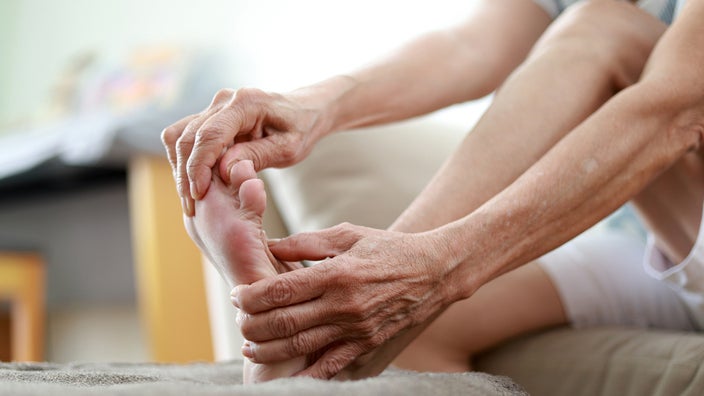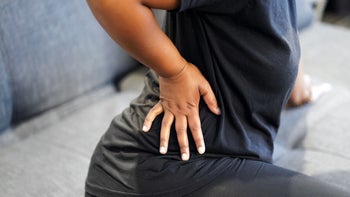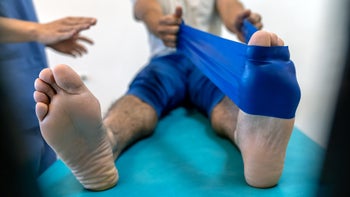
Toe Cramps: 7 Common Causes, Plus Simple Treatments
Key takeaways:
Toe cramps are due to a sudden, painful contraction of the muscles in your toes.
Common causes of toe cramping include tight or weak muscles, dehydration, injury, or poorly fitting shoes. They can also be caused by a medical condition that affects peripheral nerves or blood vessels, like diabetes.
Treatment for toe cramps includes gentle toe and foot stretching, applying heat, and staying hydrated with water or electrolyte drinks.

Toe cramps are an involuntary — and often painful — contraction of your toe muscles. A muscle cramp occurs when your muscle suddenly tightens or contracts on its own and doesn’t relax for a period of time. While muscle cramps, or “charley horse,” are common in your hamstring or calf, they can also occur in your toes.
Muscles can cramp at nighttime, during or after an activity, or for no apparent reason. These cramps can last anywhere from a few seconds to 15 minutes or longer. There are several reasons why your toes may cramp, but most cramps can often be alleviated with simple treatments at home.
Let’s look at what causes toe cramping and what you can do about it.
Search and compare options
What are the most common causes of toe cramping?
There are several possible reasons for getting toe cramps, some more common than others. Some medications can increase the risk of developing leg cramps, especially at night. And some medical conditions can also cause muscle cramps. But these are less likely to affect your toes.
Let’s take a closer look at the seven most common causes of toe cramping.
1. Tight muscles
Muscles consist of fibers that contract and relax. Your foot contains many tiny muscles that move your foot and toes. Tight muscles can disrupt this function, leading to cramping. Tightness in other muscles can also cause toe cramping. For instance, a tight calf muscle can also cause the muscles in your foot to work harder than they should, leading to toe cramps.
2. Inactivity or weak muscles
Toe cramps can also occur when starting a new exercise routine or increasing activity. If your muscles are deconditioned or weak, they can fatigue quickly. This overexertion reduces oxygen in your muscles, leading to a buildup of waste products and resulting in cramps.
3. Dehydration
Not drinking enough water can cause dehydration, which can cause muscle cramps. This often occurs if you exercise in hot weather and/or sweat a lot. Significant sweating can cause water loss and electrolyte imbalance, which can lead to toe cramps.
4. Poorly fitting shoes
Shoes that don’t fit correctly or squish your toes can result in foot and toe problems. They can hold your foot in an awkward position, leading to cramping. Examples include high heels or shoes that are too big or loose, causing your toes to grip harder. Other signs of poorly fitted shoes include calluses, blisters, and bruised toenails.
Diabetic neuropathy can cause cramping toes. It can also cause numbness and tingling, but it’s not the only culprit. Check out these common causes of toe numbness and tingling.
If you have leg cramps, your medication could be to blame. Learn which ones can cause cramps and when to talk to your prescriber about them.
“Claw toe” happens when your toe gets stuck in a bent position. This is more common with age, but wearing the right kind of shoes can make a difference.
5. Sprains or strains
Injuring the muscles or ligaments in your ankle or foot can also cause foot and toe cramping. This can happen during sports or everyday activities, like stepping off a curb wrong. Common injuries include an ankle sprain or a calf strain.
6. Poor circulation
Sitting with your legs crossed or remaining in one place for too long can reduce blood flow to your feet and toes. This can cause your toes to cramp.
Certain medical conditions like peripheral artery disease or diabetes can also cause poor circulation by narrowing your arteries. This reduces blood flow to your feet and can also cause toe cramps.
7. Nerve damage
Some medical conditions can damage the nerves in your feet, causing toe cramps and spasms. For example, diabetic neuropathy can lead to foot numbness, pain, and muscle cramps.
Medical conditions like Parkinson’s disease and multiple sclerosis can also cause nerve damage, leading to toe cramps. Those who have these conditions may have dystonia, a condition that causes sustained muscle spasms or cramps in the feet and toes.
How do you treat cramping toes and feet?
The good news is that there are many simple treatments you can do at home to treat and prevent toe cramps.
Stretch, stretch, stretch
To help stop a toe cramp, hold the base of the foot and gently stretch your toes back. You can also dorsiflex (flex) your foot upwards to stretch all the muscles in your foot. The American Academy of Orthopaedic Surgeons (AAOS) recommends holding the muscle in a stretched position until the cramp relaxes.
Research suggests that daily leg stretching, specifically calf and hamstring stretches, may help reduce leg cramps at night. Try including foot and ankle strengthening exercises into your workout routine. Strengthening the muscles that support your foot may help prevent fatigue-related toe cramps. Make sure you do a warmup and cooldown before and after activity.
Massage your feet and toes
Massaging the muscles may help them stretch and also relieve pain. Gently rub the muscles in your calf, foot, and toes. You can also place a tennis ball on the ground and roll the sole of your foot on it for a gentle massage.
Apply heat
Use a heating pad or soak your feet in hot water. This can help relax the muscles in your foot and toes. Consider doing an Epsom salt bath if you’ve had a foot or ankle injury.
Stay hydrated
Keep yourself hydrated, especially during high-intensity exercise or when it’s hot outside and you’re sweating a lot. Always have a water bottle handy. Water is always a good choice, but a sports drink with electrolytes works if you’re exercising outside in the heat.
Eat a balanced diet
A well-balanced diet can help make sure you’re getting all the vitamins and minerals you need. The following foods can all help prevent an electrolyte balance, which can lead to toe cramps:
Low-fat cow’s milk
Bananas
Yogurt
Lentils
Spinach
Wear supportive, well-fitting shoes
Wear shoes that support your arch, have cushioned soles, and allow plenty of room for your toes. Opt for low heels or kitten heels instead of stilettos, and try to minimize your time in high heels.
Consider orthotics
If you get toe cramps after standing, walking, or running, talk to a physical therapist to see if orthotics or shoe inserts could help.
When should you see a healthcare professional about cramping toes?
Toe cramps often go away on their own with at-home treatment. But if they’re happening enough to interfere with your activities or quality of life, it’s probably time for a clinical evaluation.
See a healthcare professional if cramping toes:
Occur frequently
Cause severe pain
Last for a long time
Don’t respond to the conservative measures mentioned above
Happen for no identifiable reason
Occur with numbness, tingling, or weakness
If you also have calf pain, swelling, redness, and warmth to the touch, talk to your primary care physician. These could be signs of a serious condition called deep vein thrombosis.
The bottom line
Toe cramps are a common condition that can cause a sudden, painful contraction of your toe muscles. They aren’t usually serious and can be managed at home. Gentle stretches, massage, and heat can often relieve the cramp. Wearing proper shoes and staying hydrated can prevent toe cramps from occurring. Occasionally, toe cramps can be due to a medical condition, so if your toe cramps are frequent, it’s best to see a healthcare professional.
Why trust our experts?



References
Alaia, M. J., et al. (2022). Muscle cramps. OrthoInfo.
American Academy of Orthopedic Surgeons. (2022). Foot and ankle conditioning program.
Bordoni, B., et al. (2023). Muscle cramps. StatPearls.
Hawke, F., et al. (2021). Non-drug therapies for the secondary prevention of lower limb muscle cramps. The Cochrane Database of Systematic Reviews.
Kaneshiro, N. K., et al. (2023). Dehydration. MedlinePlus.
Lau, W. Y., et al. (2022). Effect of oral rehydration solution versus spring water intake during exercise in the heat on muscle cramp susceptibility of young men. Journal of the International Society of Sports Nutrition.
Lee, J., et al. (2019). The effect of calf stiffness on gait, foot pressure and balance in adults. The Journal of Korean Physical Therapy.
Lopate, G., et al. (2013). Cramps and small-fiber neuropathy. Muscle & Nerve.
McRitchie, M., et al. (2018). Footwear choices for painful feet - An observational study exploring footwear and foot problems in women. Journal of Foot and Ankle Research.
Mulcahey, M. K., et al. (2020). Sprains, strains, and other soft-tissue injuries. OrthoInfo.
National Health Society. (2023). Dystonia.
Shrimanker, I., et al. (2023). Electrolytes. StatPearls.
Stern, L. Z., et al. (1990). Chapter 53: Muscle cramps. Clinical Methods: The History, Physical, and Laboratory Examinations. 3rd edition.

























